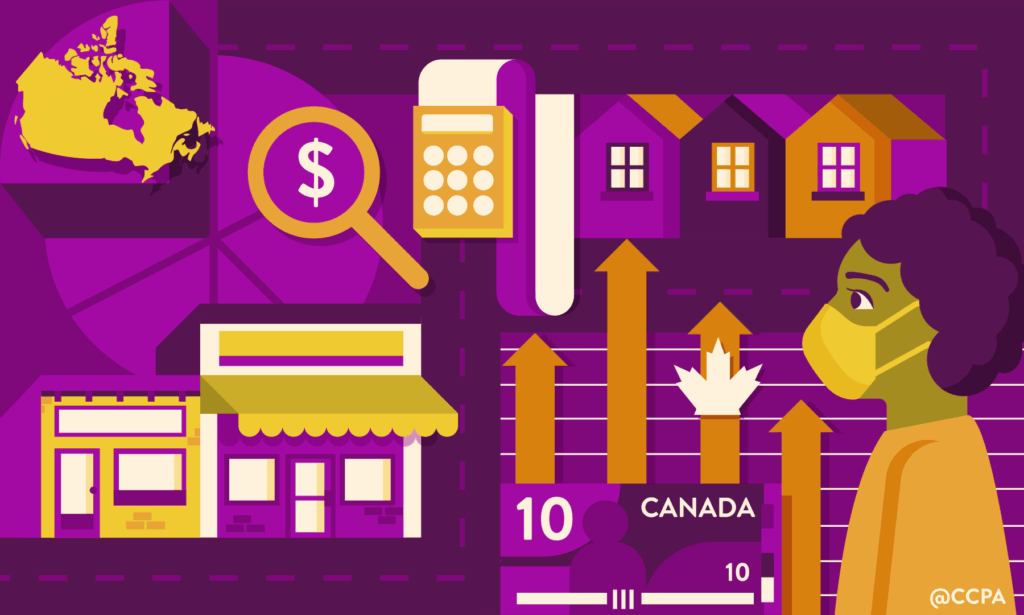Since March, a special parliamentary committee on Canada–U.S. relations has been meeting (remotely, of course) to consider the impact that the Biden administration’s proposed economic, environmental and security policies might have on Canada.
Recently, the committee turned its attention to U.S. domestic procurement preferences, namely the Buy American and Buy America programs.
The U.S. president wants a big share of the multiple trillions of dollars he plans to spend on physical infrastructure over the next decade to go to American firms and American workers. This completely predictable move from the Biden administration (as VP, Biden oversaw Obama’s economic recovery plan, which also came with Buy America conditions) has nonetheless triggered panic in Canada, much of it misplaced or at least poorly backed up by facts.
It’s not that these local preferences on U.S. procurement do not affect Canadian suppliers. They do. Unfortunately, the Canadian government doesn’t seem to have the data to show those impacts. As Doug Forsyth, director general of market access at Global Affairs Canada, told the committee on April 1, “the procurement market is a little bit opaque in terms of exact numbers.”
It’s not that these local preferences on U.S. procurement do not affect Canadian suppliers. They do. Unfortunately, the Canadian government doesn’t seem to have the data to show those impacts.
There was anecdotal evidence from the Obama days of Canadian water pipes being ripped out of the ground, and always we hear from transnational business of the potential for foreign governments to retaliate against U.S. firms. But we have no hard dollar figures, no good idea how or to what extent stimulus-specific “buy local” provisions in the U.S. hurt the Canadian economy—or if they might even have spinoff benefits here. Let’s not lose sight of the positive impacts of U.S. stimulus spending on the Canadian economy as a whole.
I am grateful to have been invited to present to the committee on Buy America policies last week. What follows is more or less what I said in that meeting, which is more or less that we should respond to Biden’s infrastructure plan with calm and ingenuity—not another lopsided, road-to-nowhere procurement deal.
There may also be opportunities to work with Biden on trade policy reforms that would give Canadian provincial and municipal governments more leeway to “buy local” too.
Buy America and Buy American
First, let’s be clear about what we’re talking about. There are a number of programs in the U.S. that give priority to American-made goods when public money is being spent on government supplies or public infrastructure.
The most commonly known are the Buy American Act of 1933, which applies to federal spending, and distinct Buy America conditions attached to federal transfers to lower levels of government, also usually for public infrastructure.
Buy American measures generally require federal agencies to favour domestic end-products or construction materials when procuring goods, except in situations where it would be impractical or overly expensive to do so. The act defines what counts as a domestic product (e.g., it must be manufactured in the U.S. and 55% of the value of its components must be mined or produced in the U.S.) and creates a system for topping up low offers that do not meet American-made criteria to favour domestic bids.
Buy America pulls together a slate of domestic content statutes and regulations in which federal funding for state and local governments (mainly for transit and highway infrastructure projects, but also water infrastructure) comes with domestic content requirements. These generally relate to the use of American iron and steel (again at 100%) and certain other manufactured goods, or they can take the shape of a minimum value for domestic components (e.g., 60%) in such goods as buses and rail cars for public transit projects.
Canadian business is generally less concerned with Buy American measures at the federal level, since these tend to be waived for suppliers from Canada and other member countries to the WTO Agreement on Government Procurement (GPA). Buy America conditions on federal transfers to lower levels of government, on the other hand, are completely excluded from the WTO procurement rules, even in U.S. states that have made other commitments to the GPA.
Steve Verheul, Canada’s lead negotiator in the NAFTA renegotiation, after going over much of this in his presentation to the Canada–U.S. relations committee earlier this month, noted that the Biden administration is “within its rights to use those programs” to apply local content quotas to COVID-19 recovery financing. Buy America is the standard operating procedure in the U.S., no matter who is in office, and the policy almost certainly helps garner public and political support for big spending. There is little Canada can do about this.
What we don’t know yet is exactly where Biden plans to attach Buy America conditions (i.e., on which projects and for what products or components) and how his administration plans to change, or tighten up, the Buy America waiver application process so that federal stimulus cash is more likely to go to U.S. firms and workers than it has in the past.
Here we have some options, which I’ll get to shortly. But before that, some thoughts on how Canada should not respond.
Buy America conditions on federal transfers to lower levels of government, on the other hand, are completely excluded from the WTO procurement rules, even in U.S. states that have made other commitments to the GPA.
When the Obama administration passed its own recovery act a decade ago—in response to mass joblessness, corporate disinvestment and cash-hoarding, in the wake of the 2008–09 financial crisis and Great Recession—Canadian business and trade-impacted provinces like Ontario despaired about its Buy America provisions.
The Canadian Manufacturers and Exports claimed “the effect would be catastrophic” and urged the Harper government to act.
After consulting the provinces, the government decided it would try to negotiate a mutually beneficial, bilateral procurement agreement with the Americans to secure preferential access to Obama’s lucrative infrastructure contracts. Maybe, the Canadians thought, they could also secure permanent procurement commitments from U.S. states to stave off future “buy local” measures.
It didn’t go well. The final deal, announced in 2010, was hugely lopsided in favour of the United States.
Canada significantly opened up provincial and local government procurement to unconditional bids from U.S. firms in return for the right of Canadian firms to bid on a tiny sliver of U.S. stimulus projects under a handful of federal programs. That hard-fought access amounted to, at best, about 2% of Obama’s initial $275 billion US procurement fund, or $4–5 billion US worth.
A 2010 CCPA report by Scott Sinclair estimated that, in exchange for these stimulus crumbs, Canada agreed to open up about $25 billion CAD worth in Canadian contracts up to September 2011, when the temporary procurement deal expired.
It was during those negotiations that Canada agreed to permanently bind Canadian provinces, for the first time, to the WTO procurement agreement, the GPA. A few years later, Canada went further for European trade negotiators by committing almost all MUSH-sector spending (municipalities, universities, school boards and hospitals) to the strict procurement rules of the Comprehensive Economic and Trade Agreement (CETA).
It was bye-bye for “buy local” measures in Canadian cities.
That hard-fought access amounted to, at best, about 2% of Obama’s initial $275 billion US procurement fund, or $4–5 billion US worth.
Canadian government officials claim this almost total liberalization of public procurement makes us global role models, “rules-based trade” leaders on the world scene. In fact, Canada remains an outlier because most countries, not just the U.S., have no intention of permanently giving up the right of local governments to use public spending to achieve broader social objectives such as sustainable local economic development.
Another result of Canada’s GPA and CETA procurement commitments is we have little left to offer the Americans in the event of a second Buy America deal. We tried that in the CUSMA negotiations, but the Trump administration did not budge. The Biden administration is similarly uninterested in procurement liberalization.
In fact, Biden is following through on Trump’s plan to revise America’s WTO commitments on procurement, to remove public spending by federal agencies on a list of medicines and active pharmaceutical ingredients.1 His administration is also talking about working with allies to revise the WTO procurement rules to make it easier for governments to spur local economic development.
Constructive engagement and emulation
So, how should Canada respond to yet another round of Buy America measures from a trade-reforming Biden administration? Let’s first put the situation in perspective. The price of Biden’s recovery plan ($2.3 trillion US) may sound high, but it’s not…at all. Progressive Democrats are calling for at least $10 trillion over 10 years and are furious that Biden set the negotiating number so low, almost guaranteeing he’ll get much less past the senate.
For a Canadian comparison, if we adjust Biden’s stimulus for population, it’s much like if Canada were to spend about $30 billion over eight to 10 years on the same priorities: roads and highways, water, clean energy, broadband, health care, etc. In other words, a pittance where major TLC (in the form of funding, with strings attached) is needed from the feds.
In contrast, the CCPA’s Alternative Federal Budget recovery plan calls for at least $80 billion in immediate new or additional funding for physical and social infrastructure and transfers. That includes a $12-billion injection to municipal governments to cover their extra COVID-related costs, and a promise to pay up to 100% of the cost of major infrastructure projects to keep the momentum going.
Of course,$100 billion US for water infrastructure, as Biden is proposing, is nothing to sneeze at from the perspective of businesses that would like to benefit from the U.S. stimulus. But, instead of fretting over what Canadian products or components may or may not be excluded through Buy America measures, we should recognize that these same products and components are needed here in Canada, and for the same purposes: transit, renewable power, broadband access, water infrastructure, hospitals and other care spaces, etc.
There are large infrastructure deficits in all of these areas in Canada. If we’re going to spend the money, and we should, why not take a page out of Biden’s playbook by finding ways to channel some of that money to domestic manufacturing, small and medium-sized enterprises, and businesses owned by women, Indigenous people and racialized people, with all the spillover benefits that this would produce?
Putting Canadian versions of Buy America and Buy American conditions (e.g., sustainability and social criteria on federal transfers to the provinces and territories) may even bring the Biden administration to the table to discuss a North American green jobs and procurement strategy, as others have called for before the Canada–U.S. relations committee.
But the main benefit of these programs is domestic. As United Steelworkers President Ken Neumann said earlier this month, "With a clear procurement strategy, Canada must prioritize the use of environmentally sustainable, low-carbon materials that will create and maintain jobs.”
If we’re going to spend the money, and we should, why not take a page out of Biden’s playbook by finding ways to channel some of that money to domestic manufacturing, small and medium-sized enterprises, and businesses owned by women, Indigenous people and racialized people, with all the spillover benefits that this would produce?
A final note on perspective
U.S. economic growth is estimated to hit 6.5% this year, according to a recent OECD report, which notes that Canada and Mexico will be the biggest beneficiaries of Biden’s stimulus-driven rebound. If Buy America and Buy American provisions are the price the Democratic administration must pay to get a larger stimulus package through the U.S. senate, Canadian firms may be counting their blessings down the line.
The icing on the cake, though, would be for Canada to launch a more ambitious Canadian infrastructure plan that would have benefits for Canadian and U.S. workers alike.
Sustainability criteria on inputs such as cement, steel, iron and aluminum would favour Canadian and U.S. producers while helping Canada meet its climate targets, as recommended by Blue Green Canada. Social criteria on public spending would direct money to businesses, workers and populations that are underserved by the economy, growing these firms in line with Canada’s inclusive trade agenda.
Obviously, the federal government has a role to play in monitoring the rollout of Biden’s stimulus and ensuring waivers for Canadian firms wherever that’s possible. But it needn’t be Canada’s only strategy.
The government can budget for Buy America uncertainty by increasing the pool of infrastructure projects on which Canadian suppliers can bid and ensuring public spending prioritizes a just, green recovery.
Footnotes
1 On April 20, the USTR withdrew this push to remove these goods from its GPA commitments, but claimed in a statement that it "reserves the right to notify any future modifications of U.S. coverage in accordance with the terms of the revised Agreement."








